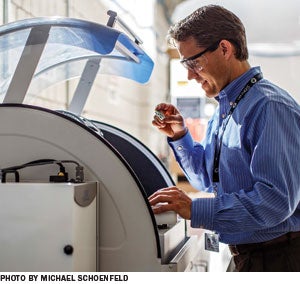The future of technology is now at research lab

When Intermountain Healthcare, Salt Lake City, announced the recent opening of a new, much larger space for its Transformation Lab, the event was significant for more reasons than one.
It not only signified a new level of commitment on the part of the health care system and its partners to conduct research and development into technology designed to improve patient care and clinical efficiency, but it also represented how far the Transformation Lab has come so quickly.
"We started out a couple of years ago in a closet, then moved to a small room and then a conference room," says Frederick Holston, chief technology officer, Intermountain.
As of August, the hands-on, construction part of the lab moved into a 20,000-square-foot building that formerly housed an outdoor patio furniture warehouse in Murray, a suburb about 10 miles from Salt Lake City. Renovation of 12,000 square feet of what's called the "Kool Span" building, named after the previous owner, was completed a few months ago with more to come.
This is in addition to an adjacent building that serves as the administrative hub of the lab and features a high tech-looking executive briefing room straight out of Star Trek. The message is clear: New cutting edge health care technology is spoken and developed here.
Intermountain has a respected history of being health care innovators and the Transformation Lab is a continuation of that mission, says Marc Probst, chief information officer, Intermountain, in a video about the lab posted on YouTube.
"How can we save a few more lives? How can we save a lot of the expenses associated with health care? We all know the problems of health care. I like the Transformation Lab because it's going to give us an opportunity to maybe do something about that," he says in the video.
The lab is exploring ideas such as the patient room of the future in which patients communicate in real time with the doctor via a tablet device they also can use to order food and movies. The lab also is testing a wireless monitoring system that has sensors that measure a patient's vital signs and communicates with a nurses' station.
It also is exploring an advanced lighting system with colors that adjust to the patient's needs or mood and development of a 3-D printer that will produce medical devices and circuit boards.
The lab collaborates with its high-tech partners such as Intel, Dell and such local companies as Xi3 and Sotera Wireless that have long-standing relationships with Intermountain that began when they were suppliers, Holston says. They provide technical expertise on developing systems or devices and serve as important investors too.
The lab fills a void by providing a place where Intermountain employees or startups with health care technology ideas can bring their proposals for possible development, Holston says.
"The lab's job is not to be the think tank to come up with all the cool ideas," Holston says. "We are a resource to Intermountain Healthcare, to our partners, to the startups and to our employees to bring these ideas to life so that we can move them into health care."
Holston explains how an Intermountain nurse came up with an idea for a hand-washing watch that would display red to gently remind nurses that they need to wash their hands and then change to green after fulfilling the task.
The lab built a prototype of the watch and is testing its validity. If it works out, Intermountain will seek a manufacturer and also become the first customer, according to Holston.
"Our first goal is to impact patient care at Intermountain Healthcare. We believe if we can't impact health care at Intermountain, we're not going to do any good anywhere else," he says.
Eventually, the plan is to make any new devices or systems the lab creates available to all health care systems.
Jeff Ferenc is senior editor of Health Facilities Management.




